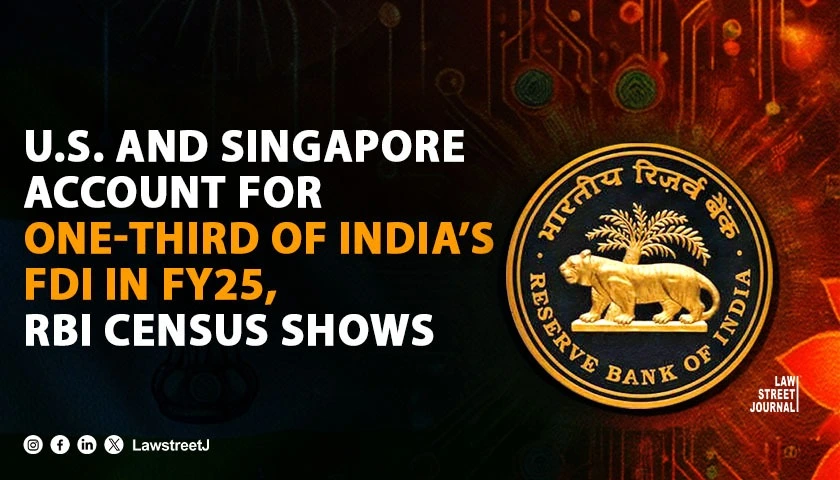New Delhi: The Reserve Bank of India (RBI) has released provisional findings from its Foreign Liabilities and Assets (FLA) Census for 2024–25, revealing that the United States and Singapore together contributed more than one-third of India’s total foreign direct investment (FDI) during the financial year ending March 2025. The data highlights the continuing dominance of these two economies in India’s investment landscape and their central role in shaping ownership patterns across sectors.
According to the RBI’s provisional census, over 75% of Indian companies reporting foreign direct investment were subsidiaries of overseas firms, defined as entities where a single foreign shareholder owns more than half of total equity. This classification follows the rules laid out under the Foreign Exchange Management Act (FEMA), 1999, which governs cross-border capital flows and requires detailed disclosure of foreign ownership.
Out of 45,702 entities that participated in the FY25 census, 41,517 had either foreign direct investment (FDI) or overseas direct investment (ODI) recorded in their balance sheets as of March 2025. Of these, 33,637 companies had participated in the previous census, while 7,880 were new entrants this year. The RBI noted that around 97% of these firms were unlisted, indicating that much of India’s foreign equity remains concentrated in private entities rather than publicly traded corporations. This pattern underscores the growing importance of privately held subsidiaries managed by foreign parent companies. Under FEMA, such entities must file annual returns and maintain transparency in their shareholding structures, ensuring compliance with domestic and international regulatory norms.
U.S. and Singapore Maintain Lead as Top Investors
The RBI’s data confirms that the United States and Singapore remain India’s two largest sources of FDI, together accounting for more than one-third of total inflows during FY25. This trend continues from previous years, supported by strong bilateral ties, tax and trade cooperation, and sustained sectoral interest in technology, finance, infrastructure, and manufacturing. Although the census does not provide exact country-wise figures, earlier data from the Department for Promotion of Industry and Internal Trade (DPIIT) shows that both nations have invested several billion dollars in India over the last decade across sectors such as fintech, renewable energy, e-commerce, and logistics.
Legal experts note that heavy concentration from a small number of jurisdictions requires continued regulatory vigilance. While the government’s Press Note 3 (2020) tightened scrutiny on investments from countries sharing land borders with India, the dominance of U.S. and Singaporean capital highlights the importance of diversifying FDI sources to reduce exposure to geopolitical and global-market risks.
Legal Oversight and Compliance Framework
The FLA Census, conducted under Section 45 of the Reserve Bank of India Act, 1934, is a key tool for evaluating India’s external sector position. It covers companies, limited liability partnerships (LLPs), alternative investment funds (AIFs), and partnership firms with inward or outward investment exposure. Reporting entities are legally required to disclose their foreign assets, liabilities, and retained earnings. Non-compliance or inaccurate reporting may attract penalties under FEMA and the RBI’s Master Direction on reporting of FDI, ODI, and FLA.
The census data feeds into the RBI’s assessments of external vulnerabilities, informs monetary policy, and supports India’s reporting commitments to the International Monetary Fund (IMF) and other multilateral bodies. The FY25 findings also align with India’s ongoing investment reforms, including simplified compliance systems, digital reporting mechanisms, and sector-specific liberalization. However, the high share of unlisted foreign subsidiaries and concentration of capital inflows from select countries point to areas requiring policy focus — particularly in boosting domestic participation and broadening the investor base.
Economists say the RBI’s findings reflect the evolving structure of India’s FDI landscape. With over three-fourths of inward-invested firms classified as foreign subsidiaries and the U.S. and Singapore together driving over one-third of total inflows, the census offers important insights into India’s capital-ownership structure. The report emphasizes the importance of maintaining transparency and compliance under FEMA and related RBI regulations while encouraging greater diversification among investment partners to strengthen long-term economic resilience.
The RBI’s 2024–25 Foreign Liabilities and Assets Census provides a comprehensive snapshot of India’s foreign investment ecosystem. It shows that U.S. and Singaporean investors accounted for more than one-third of total FDI inflows and that over 75% of reporting entities were subsidiaries of foreign firms, most of them unlisted. The findings underscore the strategic role of these two economies in India’s growth while highlighting the need for continued regulatory oversight and diversification of FDI sources.









